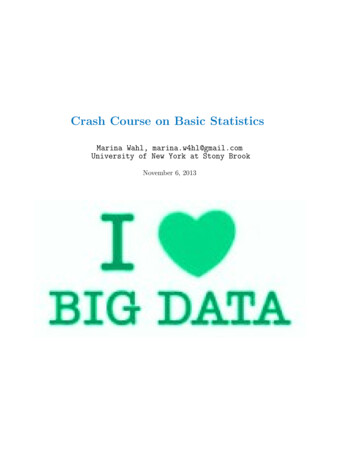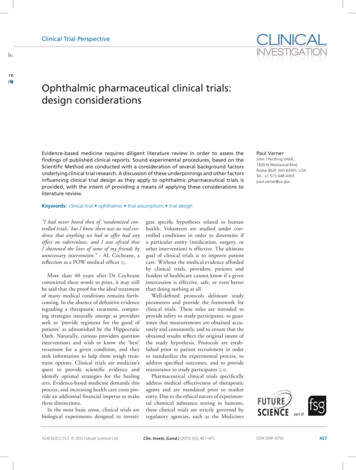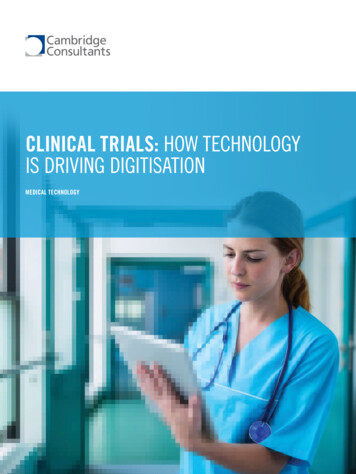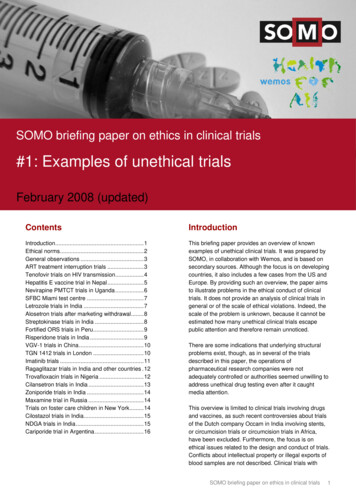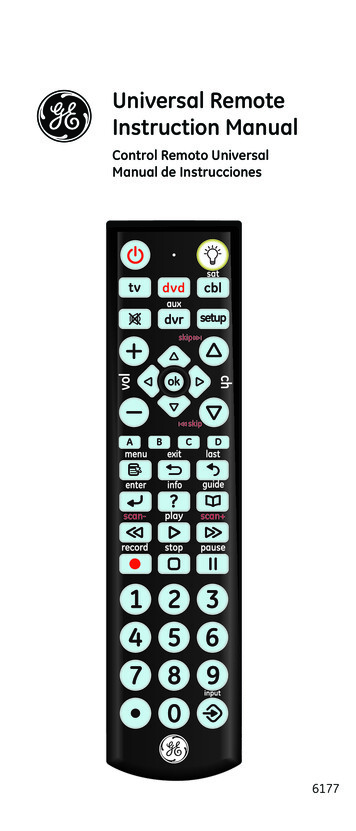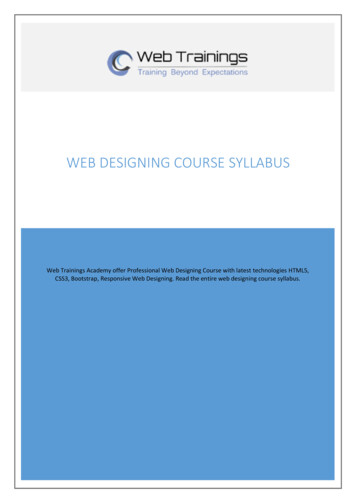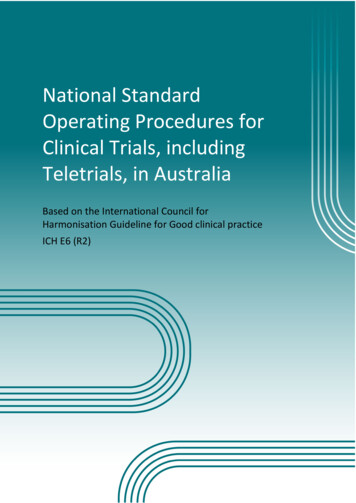
Transcription
Designing trials of Universal Basic Income for health impact: identifyinginterdisciplinary questions to addressDr Matthew Johnson,1 Elliott Johnson,2 Prof Daniel Nettle,3 Prof Kate Pickett4AbstractBackgroundA large body of evidence indicates the importance of upstream determinants to health.Universal Basic Income (UBI) has been suggested as an upstream intervention capableof promoting health by affecting material, biopsychosocial and behaviouraldeterminants. Calls are emerging across the political spectrum to introduce anemergency UBI to address socio-economic insecurity. However, although existingstudies indicate effects on health through cash transfers, UBI schemes have notpreviously been designed specifically to promote health.MethodsIn this article, we scope the existing literature to set out a set of interdisciplinaryresearch challenges to address in designing a trial of the effectiveness of UBI as apopulation health measure.ResultsWe present a theoretical model of impact that identifies three pathways to healthimpact, before identifying open questions related to regularity, size of payment, needsbased supplements, personality and behaviour, conditionality, and duration.ConclusionsThese results set, for the first time, a set of research activities required in order tomaximise health impact in UBI programmes.Keywords: Public health; Universal Basic Income; public policy; socio-economicstatus1Matthew Thomas Johnson, PhD, Senior Lecturer in Politics, Lancaster University. ORCID ID: 0000-00029987-7050. m.johnson@lancs.ac.uk2Elliott Aidan Johnson, MA, Disability Research Consultant. ORCID ID: iel Nettle, Professor of Behavioural Science, Newcastle University. ORCID ID: Kate E. Pickett, Professor of Epidemiology, University of York. ORCID ID: 0000-0002-8066-8507.kate.pickett@york.ac.uk1
IntroductionThe UK Government has recently committed to a ‘prevention agenda’.1 With concern aboutthe NHS being understood as the ‘National Hospital Service’,2 there is increasing focus onpreventing morbidity. In this regard, a large body of evidence indicates the impact of socioeconomic status on health outcomes, as has been evident in COVID-19 mortality rates. A recentissue of The Lancet Public Health3 explores that relationship in modern Britain and examinesthe effect of ‘upstream interventions’ on health. We have suggested that Universal BasicIncome (UBI) – an unconditional, regular cash transfer to all adult citizens – could serve as onesuch intervention by affecting material, biopsychosocial and behavioural pathways to health.4In part because of this research, the UK Labour Party committed to trialling UBI in such citiesas Liverpool and Sheffield in its 2019 Manifesto.5(pp.17-19) 6(p.60) Demonstrating cross-partysupport for the policy, Hull City Council has sought permission to conduct a trial of UBI in thewake of the Conservative Party’s success in the 2019 General Election,7 while the ScottishNational Party has called for its emergency introduction during the COVID-19 pandemic.8The fact that policy makers are concerned with trialling the policy indicates both theexpected controversy attached to granting citizens ‘free money’ and belief that evidence-basedpolicy retains the capacity to transform public opinion.9 These assumptions persist despiteconcern about the ineffectiveness of quantitative data in securing public support10 and thepossibility of confirmation bias leading to ‘policy-based evidence’, in which evidence isinterpreted through the lens of existing beliefs .11 While empirical examination of UBI iscatching up with the extensive body of theoretical work,12 studies conducted on cash transfersare of such varying quality, scale and focus that few substantive conclusions can be drawn onthe policy’s potential effect on health. In this article, we scope the existing literature on UBI topresent a case for prospective health impact that is universally applicable. However, given theauthors’ geographic area of research and practise, we situate discussion of policy implicationswithin a UK context.This article identifies a set of interdisciplinary research challenges to address in designing aneffective UBI trial for health promotion. We establish the parameters of existing trials and mapout three pathways to health impact before identifying challenges related to size of payment,needs-based supplements, personality and behaviour and duration. We do not present this workas comprehensive (or the reviews as systematic), but as the first attempt to codify the questionsthat need to be answered in advance of and during trials.Data from existing cash transfersUBI is a system of universal cash transfers to (adult) citizens. It ensures a minimum income,but, unlike the UK’s Universal Credit,13 is not allocated on the basis of need or means. It isoften associated with left-wing political parties, but has been supported by thinkers across thepolitical spectrum as a means of promoting rights,14 efficiency,15 growth16 and supportingflexibility in the labour market.17 Because UBI has previously been seen as an economicinstrument, the notion of deploying UBI specifically for reasons of public health, andgrounding those reasons in the medical literature, marks a key development within the field.4However, before we can consider that case, it is essential to clarify that there have beenfew examples of cash transfer programmes in general and those presented as comparable toUBI differ significantly in ways that may restrict the generalisability of findings. A full reviewof such trials was undertaken by Gibson, Hearty and Craig,18 and as such, we do not seek toreplicate this work here. Perhaps the most commonly cited examples of trials are those thatrelate to Negative Income Tax (NIT) provision. NIT schemes ensure that citizens’ incomesreach a basic threshold by providing payment where income from other sources fails to meetthe threshold, with payment gradually tapering and being replaced by taxation as incomes from2
other sources increase. Gibson, Craig and Hearty19(p.28) identified five NIT trials in NorthAmerica: the New Jersey Graduated Work Incentive Experiment20, the Rural IncomeMaintenance Experiment (RIME),21 the Gary Income Maintenance Experiment,22 theSeattle/Denver Income Maintenance Experiment (SIME/DIME)23 and the Manitoba BasicAnnual Income Experiment (Mincome).24 These targeted interventions were much closer toUniversal Credit in the UK and lacked both the universality and unconditionality of UBI. Thesame is true of the 2017-2018 Finnish trial, which constituted an unconditional minimumincome guarantee for benefit claimants.25Whereas these schemes differ in terms of their being conditional on low income, othersystems differ in terms of their being conditional on an individual’s membership of an ethnicgroup, rather than citizenship of a country. These include the US case of Tribal Casino CashTransfers (such as the Great Smoky Mountains Study), in which Indigenous Americans receivetwice annual taxable cash payments.26 Beyond this, while proponents of UBI in liberaldemocracies generally support weekly or monthly transfers to mimic salaries, the Tribaltransfers and the Alaska Permanent Dividend Fund involve annual or biannual transfers).27Moreover, even programmes designed experimentally to examine impact of cashtransfers on indicators of health and wellbeing differ radically. For example, Haushofer andShapiro’s28 trial of unconditional cash transfers to low-income household units in Kenya notonly focused on households instead of individuals, it also involved trialling payments to thehusband and the wife, varying the size of the payment and using lump-sum and monthlypayment schedules.29 In the Madhya Pradesh Unconditional Cash Transfer Pilot (MPUCT),payments of varying sizes to adults and children within villages were made via bank andphysical ‘cash-in-hand’ transfers over 12 months. However, this was not permanent andrepresented an extremely low proportion of the cost of living for the very poorest in Indiansociety.30As a universal benefit, UBI cannot be properly evaluated without evidence of its impacton all individuals, including those from middle and higher socioeconomic backgrounds.Moreover, some of the health effects may be emergent on the policy’s being applied atpopulation scale, rather than restricted or experimental subsets. As such, contrary to assertionin other accounts,31 no trial of an unconditional, universal payment across a populationencompassing all individuals irrespective of socio-economic status has occurred, meaning thatevidence of impact has to be carefully contextualised.Evidence of impact on healthGiven the disparate nature of studies, findings presented as evidence of the impact of the policyhave to be understood as necessarily limited and context specific. However, trials ofprogrammes that resemble elements of UBI have noted an effect on health.31 Kangas et al.25(p.24)found that respondents in the two-year-long Finnish trial reported reduced stress relatedto economic circumstances. The Finnish Ministry of Social Affairs and Health recentlyreported that analyses of the full trial showed that those who received the UBI ‘described theirwellbeing more positively than respondents in the control group. They were more satisfied withtheir lives and experienced less mental strain, depression, sadness and loneliness’.32 The UScase of Gary Indiana, in which low income families received a minimum income guarantee,demonstrated a positive impact on birth weight.22 Similarly, Chung, Ha and Kim’s33 study ofthe Alaska Permanent Fund Dividend – which varies each year and was distributed to everyindividual residing there for more than six months – found that birthweight increased by 17.7gper 1,000 received by the household compared with babies born in states with the sameobservable birthweight pattern in the pre-treatment period. The likelihood of low birthweightwas also reduced by 14% (0.7 percentage points). The MPUCT pilot was associated with a46% reduction in illness and injury not requiring inpatient hospital treatment, but no impact on3
more serious ill-health, perhaps because of the limited period of intervention.34 Forget’s24 studyof Mincome established a series of impacts, such as decreased hospital admissions andimproved adult mental health, the latter of which was also found in RIME.35 Using GreatSmoky Mountains Study data, Costello et al.36 found reduced rates of psychiatric and substanceabuse disorders among children whose family income was supplemented as a result of theTribal payments compared with non-tribal children. This effect persisted into adulthood.Not all the impacts are health-promoting. Evans and Moore37 demonstrate a 13%increase in deaths among urban Alaskans in the week following annual payment of the Alaskadividend. Bruckner, Brown and Margerison-Zilko38 found that the risk of accidental death morethan doubled in the month after the biannual Eastern Cherokee payment. While there is primafacie reason to suppose that the severity of impact associated with sudden (bingeing) increasein activity in response to the lump sum (including through alcohol and narcotic consumption)would not be as marked with weekly or monthly payments, this can only be verified throughexamination of the effect of such payments at population level.Pathways to health impactWe suggest that are three main qualitatively distinct, but potentially mutually reinforcing,prospective biopsychosocial pathways to impact on health.4 Each relates to the effect of theintervention on the social determinants of health. Our unique model of impact (see fig. 1) buildsupon and expands the findings of The Black Report,39 but assesses UBI as a universal upstreamintervention as opposed to the targeted interventions proposed in the Report’srecommendations. The direct health impacts may be interrelated, but, epidemiologically, it isnot possible, in the absence of representative trials, to establish the extent to which and thecircumstances under which they interrelate.The first pathway is impact on resource scarcity. Absolute poverty imposes limits onthe quality and quantity of resources to which individuals have access in satisfying their needs.Where UBI increases resources and reduces absolute poverty, there is potential forimprovement in material capacity for promotion of health.40 This pathway is supported byreported increases in food sufficiency in several programmes (see Gary, RIME, MPUCT andCasino).The second pathway is impact on chronic stress.41 Stress is an evolutionary adaptationthat effects a cascade of biological changes that prime the body to respond first psychologicallyand then biologically to threatening stimuli.42(p.612) The medical literature indicates that longterm exposure to stress is linked to a number of health conditions.43 Chronic psychologicalstress is ‘associated with a greater risk of depression, cardiovascular disease (CVD), diabetes,autoimmune diseases, upper respiratory infections (URIs), and poorer wound healing’.43(p.5995)Stimuli for stress all relate to unpredictability.44 When individuals feel subject to processes thatcan lead to destitution, they are left in a state of perpetual preparedness for threat.45 Thisincludes the judgement of others – social evaluative threat46 where that judgement serves as acue for exclusion or domination by removing social sources of predictability (group bonds,shared resources, absence of inter-subjective threat). This is a relative, rather than absolute,source of ill-health. Where UBI can provide a bulwark against destitution, it can serve as astress-reducing means of ameliorating ‘health inequalities and the structural conditions that putpeople “at risk of risks”’.47(p.S47) As Kangas et al.25(p.25) put it, ‘The predictability of the basicincome is thought to reduce the level of stress due to less bureaucracy and more certain flowof income’.4
Figure 1. UBI model of impactThe third pathway relates to behaviour. Individuals facing scarcity or unpredictabilityin their lives may invest less in behaviours that positively promote their long-term health andwell-being.48 Explanations for this foreshortening of perspective differ, from scarcity causinga restriction on the available cognitive resources required to make good long-term decisions,49to a more immediate focus being a rational response to situations where there are immediately5
pressing challenges or the long-term future is uncertain.50 51 Perception of inequality can alsoinduce violent and dangerous behaviours; individuals in situations of disadvantage whoperceive little prospect of ‘catching up’ with the rest of society through legitimate means maybe more likely to opt for these.52 One advantage of UBI schemes is that they mark out allmembers of society as equal in an important and visible sense: all get an equal share, and donot have to go through assessments that some find demeaning,40 in which they are powerless,in order to get it. Thus, their effect on perceived inequality may be greater than their actualredistributive effect.The conditionality of current welfare systems can exacerbate behavioural effects onhealth: individuals may choose behaviours that diminish their health in order to qualify forconditional welfare support53 54; or may avoid addressing underlying conditions for fear oflosing pay.40 By increasing anticipated long-term survival and by removing behaviouraldisincentives to health, UBI may foster health-promoting decisions. This may be indicated bya decrease in health-reducing behaviour among recipients of Tribal Cash Transfers.36The model of health impact stems from the existing literature on income (size, sourceand conditionality) and health and also sets out the unique features of UBI as a public healthintervention to enable design of trials capable of evaluating the intervention effectively.Uniquely, it suggests that UBI is specifically valuable as an upstream intervention by virtue ofits ability to offer predictability and security to all, in contrast to targeted, conditional schemesthat are prone to arbitrary assessment.Design considerations for healthBecause UBI has been advanced most keenly by economists, trials have often been designedspecifically with effects on employment, consumption and growth in mind.25 However,designing trials to achieve health and wellbeing impact as one of several qualitatively distinct,but related, outcomes, requires a different set of considerations. There are answers to somequestions that can be given with confidence. For example, payments need to be regular andpredictable (i.e. monthly) to reduce negative impacts, such as bingeing, associated with lumpsum payments.37 38 Similarly, our model of impact indicates strongly that payments need to bebroadly unconditional, since it is predictability and security of payment that reduces stress andenables individuals to invest in long-term health promoting behaviour.48 For example, theFinnish trial found that simply substituting an unconditional for a conditional payment of 560had a significant effect on self-rated stress and other psychological aspects of wellbeing(Kangas et al. 2019, 25).25(p.25) Indeed, these impacts were felt within the duration of a twoyear trial. This indicates that, while there are many impacts that may emerge after the trial (suchas reduction in stress-related morbidity), two years presents a window in which participantsfeel secure, alter behaviour and begin to experience measurable key health outcomes that canhave cascading long-term impacts. There are, though, three issues that require furtherconsideration.Size of paymentOur model suggests that minimum payment size ought to be determined by the cost ofsatisfying basic needs. In the UK, we can ascertain this via the Joseph Rowntree Foundation’sMinimum Income Standard (MIS). This seeks to determine what households need for ‘a decentliving standard, considered the minimum by the general public’,55 which is more than survivalalone, and enough for healthy living.56 The MIS for 2019 was 313.68 per single adult (withoutchildren) per week (net of direct taxes, such as income tax and national insurance, but gross ofcouncil tax).55(p.7) The MIS cost including housing would therefore be 1,359 per month peradult or 16,311 per year, with a cost to the state of 854.7bn per year. However, there aremeans of reducing the overall burden on the state by retaining housing and council tax benefit6
and reducing the universal payment. This results in 203.90 per week, 884 per month and 10,603 per year per adult with a 555.6bn cost to the state. Clearly, this remains significant.Needs-based supplementsThe MIS cannot provide for those who have additional needs, such as disabled people,55(p.4)who constituted approximately 21% of the population in 2018/19.57(Table 4.2) Even taking intoaccount the existing targeted welfare system, Scope found that disabled adults face additionalcosts of 583 per month to have the same standard of living as their non-disabled peers.58Additionally, there is significant intersectionality between disabled people, people with longterm and multiple health conditions (including stress-related conditions,59 people with lowersocioeconomic status (SES) and older people.54(pp.118-123) As such, the health of disabled peopleis particularly prone to changes in social policy.53 Current conditional payments, such asPersonal Independence Payment (PIP), which has been gradually replacing Disability LivingAllowance since 2013, is intended to support additional need through intensive, regularassessment of the impact of impairments and health conditions. Further support is providedthrough benefits such as the weekly Carers’ Allowance (CA) to individuals who care nonprofessionally for a disabled person for at least 35 hours per week and systems like Access toWork that cover the additional costs disabled people may face in the workplace. However,assessment itself is seen as a cause of harm, since there is a perverse incentive for healthdiminishing behaviours such as inactivity53 54 and opioid prescription use40. Given that a keyjustification for UBI is its elimination of bureaucratic complexity and assessment and giventhat assessment has the potential to harm, there are grounds to remove arbitrary discriminationin assessment60 and perverse incentives in needs-based allocations. However, paying largeadditional sums in the order of 583 to all seems unfeasible, so a less onerous system ofassessment or provision of services, rather than cash for use in a market of service providers,may be preferable. Indeed, many additional needs could potentially be met through bolsteredpublic services – such as through the Labour Party’s6 proposal for a National Care Service –and provision of transport, albeit with caveats stemming from the disability rights movementthat has strongly advocated systems that promote autonomy in decision-making.61It may be that a trial should focus solely on replacement of means-tested, and leave inplace needs-tested, benefits. Alternatively, an experimental model that assesses impact ofincluding a needs-tested element could be developed.Personality and behaviourA recurring criticism of UBI is that it constitutes an incentive for behaviour conducive to illhealth and idleness. Anderson,62 for example, argues that UBI promotes freedom withoutresponsibility and undermines social obligation to work. Given that inactivity can contribute toill-health, there are reasons to examine this seriously. Evidence from a nationwide Iraniansystem of transfers63 and an analysis of 16 Basic Income Guarantee trials64 indicates thattransfers result in no meaningful reductions in employment-related activity, while, the finalreport for the Finnish trial found that the employment rate for UBI recipients improved slightlymore than for the control group.32 Moreover, to the extent there is any evidence relating tolong-term effects of unconditional cash transfers on behaviour and personality, it tends todocument positive rather than negative effects overall. Akee, Copeland, Costello andSimeonova65 found that an ‘increase in unconditional household income improves childpersonality traits, emotional well-being, and behavioral health’. Mehra, Stopnitzky andAlloush’s66 study of poor households in Uganda found that a poverty graduation programmeincreased scores on traits that represent socialization and stability, while drought had theopposite effect. This may be because, as our model suggests, reducing uncertainty andprecariousness allow a longer-term outlook. This can have significant impacts on the nature of7
work and activity people pursue,53 with selection of more meaningful activities, such as caringand entrepreneurship, improving people’s wellbeing further.67 We can only speculate on theimpact of people pursuing different careers on their previous places of employment, but thereis a body of evidence to suggest that increasing employee bargaining power improves workingconditions, making previously poorly regarded work places more attractive.5DurationFor clear financial reasons, the interventions studied are generally short-term, even if the dataon health cover a much longer period. The 2018 Finnish trial was not extended beyond twoyears, despite calls from the nation’s social security agency to do so. 68 Reporting of thisdecision focused on the schemes’ ‘failure’, in preliminary analyses, to increase employment,despite improved wellbeing for participants69 70. This perceived failure resulted from thecentre-right Government’s narrow policy objectives, which focused solely on reducingunemployment71 and ultimately the UBI recipients were shown to have increased employmentmore than controls. The pathways to health noted above require that individuals perceive theircircumstances to be predictable and secure in order for changes in behaviour to be felt andhealth outcomes measured. Practically, Government funding can likely only be committed tocover a period equal to an electoral cycle minus the time taken to establish a funding streamand project. In the UK Parliamentary system, this leaves perhaps a period of approximatelythree years.It is clear is that the duration of a pilot needs to be sufficiently long to replicate a‘feeling’ of enduring income security. The pathways to health impact noted above are unlikelyto be demonstrable if a cliff-edge return to insecurity is looming within the data-collectionperiod. There are several options available that could be explored to achieve this, includingensuring match funding from national and local government, which could be usedconsecutively to overlap separate budget periods with short-term and medium-term goals foreach partner. Again, establishing this requires collaboration between psychologists,epidemiologists and policy makers. The possibility that political considerations preclude alonger trial means that there needs to be serious methodological examination of means ofevaluating health impact via proxy measures, such as self-rated health and stress, as well asdeaths and health service utilization and biomarkers, such as inflammation. Withoutcomprehensive measurement, a short trial may underestimate long-term effects, many of whichwould emerge through prevention from income shocks for a prolonged period of individuals’lives. Moreover, given that the aetiological period of behaviours, such as smoking, extends intodecades,72 and given that one prospective impact of UBI is to affect behaviour, it is likely thatmodelling will be an essential feature of evidence gathering.4DiscussionMain finding of this study This article scopes a series of tasks to be completed in designingUBI specifically for health impact. The absence of substantive interdisciplinary collaborationon the areas above prior to other trials highlights the extent to which a significant potentialfeature of UBI’s impact has been overlooked.What is already known on this topicIt is clear that there is a great deal of evidence supporting the notion of a correlation betweenupstream economic interventions and positive physical and mental health outcomes. However,it is equally clear that there remain significant gaps in the literature relating to the optimaldesign of a trial of UBI that seeks to examine health impact.8
What this study addsThis study has identified several key questions in designing a trial of UBI for health impactand sought to make some headway in answering them. Importantly, it has also resulted in amodel of health impact that may support understanding of how such an upstream interventionmay be affected by, and impact on, the work of colleagues in a wide range of disciplines.Limitations of this studyWe did not have space to examine two related questions in this article. First, how should wemeasure health impact during and after a trial? There needs to be serious, thoroughgoingdevelopment of a universal standard in research protocols for UBI-like upstream interventionsin order that impact can be evaluated accurately. We set out elsewhere73 specific objectives tothis end, arguing that two types of protocols are required: 1) for pilot interventions with specificcohorts in order for proof of concept and refinement of trials and 2) for trials in communitieswith over 50,000 inhabitants in which the multiple impacts of the intervention can be felt at acollective level. Second, how should UBI be funded if significant health impact can bedemonstrated? We have developed a method for calculating through microsimulationmodelling both the cost, health impact and funding regime for a UBI designed for health.74Here, it is important to note that, in the time of a pandemic, savings in substantial healthcareexpenditure from UBI are likely to be more attractive than the economic case alone, 41 withevidence that perceptions of reasonable public spending have changed.75 In that light, one finalconsideration that we cannot address here is that of scale. The smaller the trial, the smaller theimpact of individual-level effects on the economy, including inflation, housing costs andwages. If governments are serious about trials as a means of providing evidence for policy, anysuch UBI trial needs to be large – perhaps at whole city level – in order for side-effects andunintended consequences of payments to individuals to become clear.References1Department of Health and Social Care. Prevention is better than cure. London: GOV.UK, rnment/uploads/system/uploads/attachment data/file/753688/Prevention is better than cure 5-11.pdf (10 January 2019, date last accessed).2Department of Health and Social Care, Hancock M. Prevention is better than cure – Matt Hancock’s speech toIANPHI. GOV.UK (online) 2018. is-better-than-curematt-hancocks-speech-to-ianphi. (10 January 2020, date last accessed).3The Lancet Public Health. Income, health, and social welfare policies. Lancet Public Health 2020;5(3):e127.doi: 10.1016/S2468-2667(20)30034-7.4Johnson EA, Johnson MT, Webber L. Measuring the health impact of Universal Basic Income as an upstreamintervention: holistic trial design that captures stress reduction is essential. Evid Policy 2020. doi:10.1332/174426420X15820274674068.5Standing G. Basic Income as Common Dividends: Piloting a Transformative Policy. London: ProgressiveEconomy Forum, 2019. uploads/2019/05/PEF Piloting Basic Income Guy Standing.pdf. (10 February 2020, date lastaccessed).6The Labour Party. The Labour Party Manifesto 2019. London: The Labour Party, /11/Real-Change-Labour-Manifesto-2019.pdf. (14 October 2020,date last accessed).9
7Halliday J. Hull asks to be first UK ci
flexibility in the labour market.17 Because UBI has previously been seen as an economic . (SIME/DIME)23 and the Manitoba Basic Annual Income Experiment . The direct health impacts may be interrelated, but, epidemiologically, it is not possible, in the absence of representative trials, to establish the extent to which and the .
